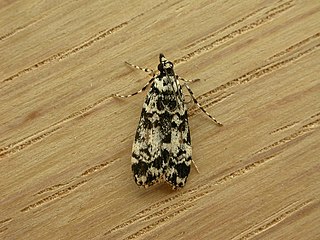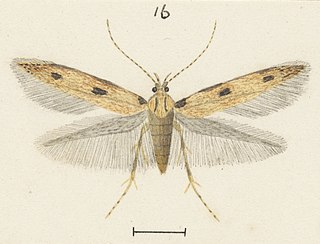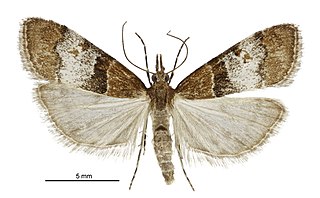
Eudonia aphrodes is a species of moth of the family Crambidae described by Edward Meyrick in 1884. It is found in Australia, where it has been recorded from New South Wales.

Zealandopterix zonodoxa is a moth of the family Micropterigidae. It is endemic to New Zealand and is located from Hawkes Bay north as well as on Poor Knights, Little Barrier and the Great Barrier Islands. It is the smallest micropterigid in New Zealand and the shiny white markings on the forewing of this species display variation. It is a moth that is active during the day, but has been collected using UV light. Adults are on the wing from September to March and the species has been witnessed visiting the flowers of Nīkau and Cordyline pumilio in large numbers. It inhabits a wide variety of moist indigenous forest but is associated with forests in which podocarps are common. Larvae have been sieved from rotten wood on the floor of a mixed podocarp/broadleaf forest or extracted from moss or from bryophytes.

Pyroderces aellotricha, also known as the Cosmet moth, is a moth of the family Cosmopterigidae. It is found in New Zealand, in Australia and the Cook Islands.

Labdia anarithma is a moth of the family Cosmopterigidae. It was described by Edward Meyrick in 1888. It is found in New Zealand and throughout Australia. Adults are on the wing from December to March and are day flying. They have been collected by sweeping bracken fern.

Scoparia chalicodes is a species of moth in the family Crambidae. This species was named by Edward Meyrick in 1884. Meyrick gave a fuller description of this species in 1885. S. chalicodes is endemic to New Zealand.

Pyrgotis eudorana is a species of moth of the family Tortricidae. It is endemic in New Zealand and has been observed in both the North and South Islands. However it is regarded as a rare insect. This species inhabits native forest. Larvae exclusively feed on Muehlenbeckia australis and adults are on the wing from November to April. Adults are attracted to light.

Antiscopa acompa is a moth in the family Crambidae. It was first described by Edward Meyrick in 1884. It is endemic to New Zealand and is found both the North and South Islands. The species inhabits native forest and adult moths are attracted to light.
Eudonia homala is a moth in the family Crambidae. It was described by Edward Meyrick in 1885. It is found in Australia, where it has been recorded from South Australia.

Eudonia leptalea is a moth in the family Crambidae. This species is endemic to New Zealand, including the Chatham Islands.

Eudonia psammitis is a moth in the family Crambidae. It was named by Edward Meyrick in 1884. Meyrick gives a description of the species in 1885. It is endemic to New Zealand, including the Campbell Islands.

Eudonia meliturga is a moth in the family Crambidae. It was described by Edward Meyrick in 1905. This species is endemic to New Zealand.
Scoparia acropola is a moth in the family Crambidae. It was described by Edward Meyrick in 1885. It is found in Australia, where it has been recorded from Tasmania.
Scoparia philonephes is a moth in the family Crambidae. It is found in Australia, where it has been recorded from Victoria and South Australia.

Anisoplaca acrodactyla is a species of moth of the family Gelechiidae. It was described by Edward Meyrick in 1907 and is endemic to New Zealand. This species has been observed in South Island as well as in the North Island. Larvae feed on species in the genera Hoheria and Plagianthus including the species Plagianthus regius'.

Tingena chloritis is a species of moth in the family Oecophoridae. It is endemic to New Zealand and has been found in the South Island. Larvae of this species feed on leaf litter. The adults of this species are light flyers and are attracted to light.

Tingena horaea is a species of moth in the family Oecophoridae. It is endemic to New Zealand and have been observed in both the North and South Islands. The adults are on the wing in January.

Tingena letharga is a species of moth in the family Oecophoridae. It is endemic to New Zealand and has been observed in Otago. Adults are on the wing in December and January.

Atomotricha oeconoma is a moth in the family Oecophoridae first described by Edward Meyrick in 1914. It is endemic to New Zealand and has been observed at Mount Taranaki, Wellington and in Dunedin. The adults emerge in June. The female adult is semi-apterous and is incapable of flight.

Trachypepla photinella is a moth of the family Oecophoridae first described by Edward Meyrick in 1883. It is endemic to New Zealand and has been collected in Wellington, Wainuiomata, D'Urville Island and Christchurch. The preferred habitat of this species is native forest and adults are on the wing from December until February.

Trachypepla protochlora is a moth of the family Oecophoridae first described by Edward Meyrick in 1883. It is endemic to New Zealand and is found in both the North and South Islands. The preferred habitat of this species is native forest and adults are on the wing from October until February. Adults can be variable in their green shaded colour as well as in the intensity of markings on their forewings. The greenish ground colouration of this moth ensures they are well camouflaged when at rest on green mosses and lichens.
















